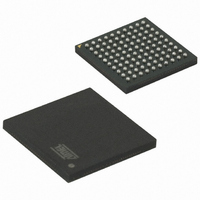ATSAM3U4CA-CU Atmel, ATSAM3U4CA-CU Datasheet - Page 370

ATSAM3U4CA-CU
Manufacturer Part Number
ATSAM3U4CA-CU
Description
IC MCU 32BIT 256KB FLSH 100TFBGA
Manufacturer
Atmel
Series
SAM3Ur
Specifications of ATSAM3U4CA-CU
Core Processor
ARM® Cortex-M3™
Core Size
32-Bit
Speed
96MHz
Connectivity
EBI/EMI, I²C, MMC, SPI, SSC, UART/USART, USB
Peripherals
Brown-out Detect/Reset, DMA, I²S, POR, PWM, WDT
Number Of I /o
57
Program Memory Size
256KB (256K x 8)
Program Memory Type
FLASH
Ram Size
52K x 8
Voltage - Supply (vcc/vdd)
1.65 V ~ 1.95 V
Data Converters
A/D 4x10b, 4x12b
Oscillator Type
Internal
Operating Temperature
-40°C ~ 85°C
Package / Case
100-TFBGA
Processor Series
ATSAM3x
Core
ARM Cortex M3
Data Bus Width
32 bit
Data Ram Size
52 KB
Interface Type
3xUSART, TWI, 4xSPI, Bus
Maximum Clock Frequency
96 MHz
Number Of Programmable I/os
57
Number Of Timers
8
Operating Supply Voltage
1.62 V to 3.6 V
Maximum Operating Temperature
+ 85 C
Mounting Style
SMD/SMT
3rd Party Development Tools
JTRACE-CM3, MDK-ARM, RL-ARM, ULINK2
Development Tools By Supplier
ATSAM3U-EK
Minimum Operating Temperature
- 40 C
Lead Free Status / RoHS Status
Lead free / RoHS Compliant
Eeprom Size
-
Lead Free Status / Rohs Status
Lead free / RoHS Compliant
Available stocks
Company
Part Number
Manufacturer
Quantity
Price
Part Number:
ATSAM3U4CA-CU
Manufacturer:
ATMEL/爱特梅尔
Quantity:
20 000
- Current page: 370 of 1171
- Download datasheet (25Mb)
25.12.3
25.12.3.1
25.12.3.2
25.12.4
25.13 Data Float Wait States
370
370
SAM3U Series
SAM3U Series
Reload User Configuration Wait State
Read to Write Wait State
User Procedure
Slow Clock Mode Transition
The user may change any of the configuration parameters by writing the SMC user interface.
When detecting that a new user configuration has been written in the user interface, the SMC
inserts a wait state before starting the next access. The so called “Reload User Configuration
Wait State” is used by the SMC to load the new set of parameters to apply to next accesses.
The Reload Configuration Wait State is not applied in addition to the Chip Select Wait State. If
accesses before and after re-programming the user interface are made to different devices
(Chip Selects), then one single Chip Select Wait State is applied.
On the other hand, if accesses before and after writing the user interface are made to the same
device, a Reload Configuration Wait State is inserted, even if the change does not concern the
current Chip Select.
To insert a Reload Configuration Wait State, the SMC detects a write access to any
SMC_MODE register of the user interface. If only the timing registers are modified
(SMC_SETUP, SMC_PULSE, SMC_CYCLE registers) in the user interface, the user must vali-
date the modification by writing the SMC_MODE register, even if no change was made on the
mode parameters.
A Reload Configuration Wait State is also inserted when the Slow Clock Mode is entered or
exited, after the end of the current transfer (see
Due to an internal mechanism, a wait cycle is always inserted between consecutive read and
write SMC accesses.
This wait cycle is referred to as a read to write wait state in this document.
This wait cycle is applied in addition to chip select and reload user configuration wait states
when they are to be inserted. See
Some memory devices are slow to release the external bus. For such devices, it is necessary to
add wait states (data float wait states) after a read access:
The Data Float Output Time (t
TDF_CYCLES field of the SMC_MODE register for the corresponding chip select. The value of
TDF_CYCLES indicates the number of data float wait cycles (between 0 and 15) before the
external device releases the bus, and represents the time allowed for the data output to go to
high impedance after the memory is disabled.
Data float wait states do not delay internal memory accesses. Hence, a single access to an
external memory with long t
memory.
The data float wait states management depends on the READ_MODE and the TDF_MODE
fields of the SMC_MODE register for the corresponding chip select.
• before starting a read access to a different external memory,
• before starting a write access to the same device or to a different external one.
DF
will not slow down the execution of a program from internal
DF
Figure 25-13 on page
) for each external memory device is programmed in the
“Slow Clock Mode” on page
367.
381).
6430D–ATARM–25-Mar-11
6430D–ATARM–25-Mar-11
Related parts for ATSAM3U4CA-CU
Image
Part Number
Description
Manufacturer
Datasheet
Request
R

Part Number:
Description:
KIT EVAL FOR AT91SAM3U CORTEX
Manufacturer:
Atmel
Datasheet:

Part Number:
Description:
AT91 ARM Thumb-based Microcontrollers
Manufacturer:
ATMEL [ATMEL Corporation]
Datasheet:

Part Number:
Description:
DEV KIT FOR AVR/AVR32
Manufacturer:
Atmel
Datasheet:

Part Number:
Description:
INTERVAL AND WIPE/WASH WIPER CONTROL IC WITH DELAY
Manufacturer:
ATMEL Corporation
Datasheet:

Part Number:
Description:
Low-Voltage Voice-Switched IC for Hands-Free Operation
Manufacturer:
ATMEL Corporation
Datasheet:

Part Number:
Description:
MONOLITHIC INTEGRATED FEATUREPHONE CIRCUIT
Manufacturer:
ATMEL Corporation
Datasheet:

Part Number:
Description:
AM-FM Receiver IC U4255BM-M
Manufacturer:
ATMEL Corporation
Datasheet:

Part Number:
Description:
Monolithic Integrated Feature Phone Circuit
Manufacturer:
ATMEL Corporation
Datasheet:

Part Number:
Description:
Multistandard Video-IF and Quasi Parallel Sound Processing
Manufacturer:
ATMEL Corporation
Datasheet:

Part Number:
Description:
High-performance EE PLD
Manufacturer:
ATMEL Corporation
Datasheet:

Part Number:
Description:
8-bit Flash Microcontroller
Manufacturer:
ATMEL Corporation
Datasheet:

Part Number:
Description:
2-Wire Serial EEPROM
Manufacturer:
ATMEL Corporation
Datasheet:











